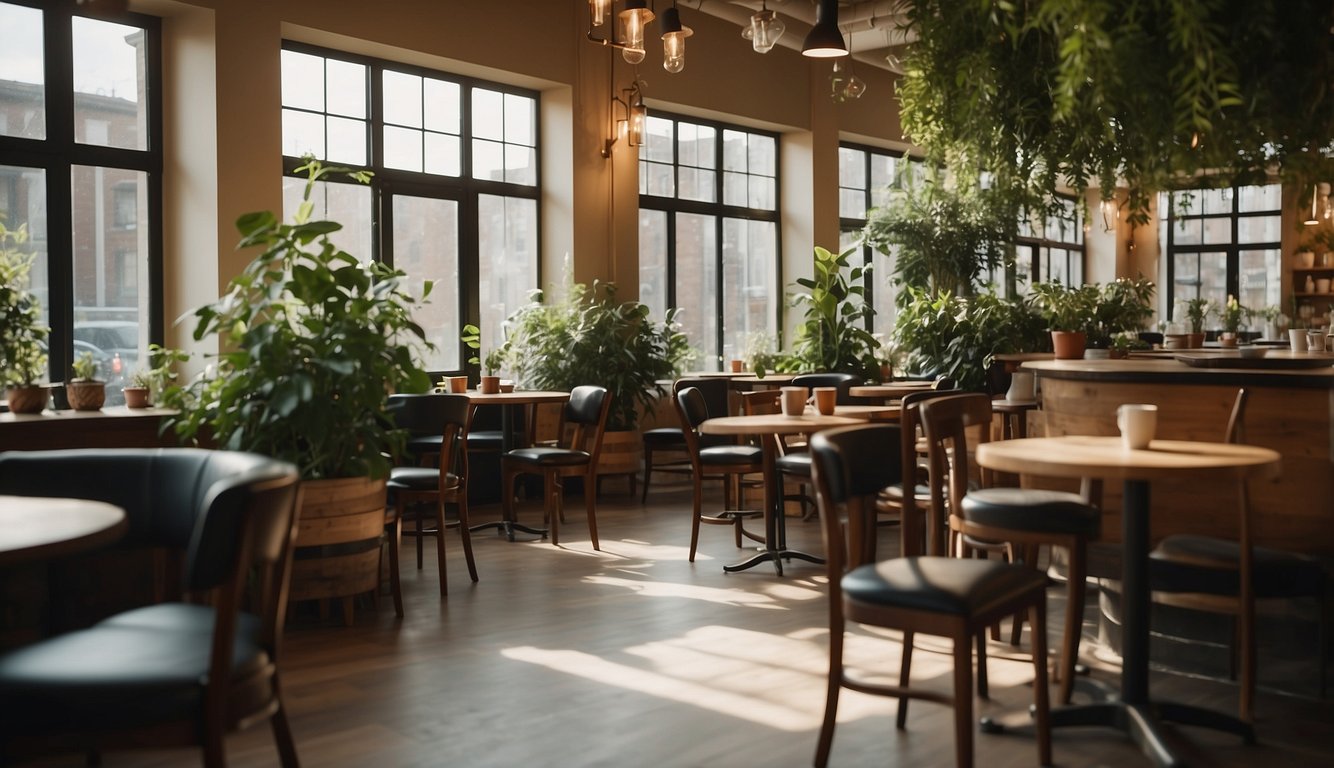As an avid coffee drinker and plant lover, I was ecstatic to discover the coffee house plant. Not only is this plant a beautiful addition to any home, but it also provides the opportunity to grow your own coffee beans. The coffee house plant, also known as Coffea arabica, is a species of flowering plant native to Ethiopia.
Growing a coffee house plant requires specific care and attention, but it is well worth it for those who love coffee and gardening. The plant thrives in a slightly acidic soil and needs to be placed in a location near a window but not in direct sunlight. It is important to maintain a room temperature between 65°F and 80°F to ensure optimal growth. With proper care, the coffee house plant can produce white flowers and berries that contain the coffee “beans.”
Understanding Coffee House Plants
Coffea Species Overview
As a coffee lover, I have always been fascinated by coffee plants, which are tropical, perennial shrubs that belong to the Rubiaceae family.
The most common species of coffee plants used for coffee production are Coffea arabica, Coffea canephora, and Coffea liberica.
Coffea arabica is the most popular species, accounting for about 60% of the world’s coffee production.
Coffea canephora, also known as Robusta, is the second most popular species and is known for its high caffeine content.
Coffea liberica is the least popular species, accounting for less than 1% of the world’s coffee production.
Historical Significance
Coffee plants have a rich history, dating back to the 15th century when they were first discovered in Ethiopia. They were later introduced to the Arabian Peninsula, where they were cultivated and traded.
Coffee houses became popular in the Middle East, and coffee soon became a global commodity.
Today, coffee is one of the most widely consumed beverages in the world, with over 2.25 billion cups consumed every day.
Botanical Characteristics
Coffee plants are small trees or shrubs that can grow up to 30 feet tall in their natural habitat. However, when grown as houseplants, they usually reach a height of 6 to 8 feet.
They have glossy, dark green leaves and white, fragrant flowers that bloom in the spring.
The fruit of the coffee plant is a bright red or purple berry that contains two coffee beans.
The beans are harvested, roasted, and ground to make coffee.
Coffee plants require a warm, humid environment to thrive.
They prefer temperatures between 60°F and 70°F and high humidity levels.
They also require well-draining soil that is rich in organic matter.
When grown as houseplants, coffee plants should be watered regularly, but not overwatered, as this can lead to root rot.
They should also be fertilized once a month during the growing season.
Optimal Growing Conditions
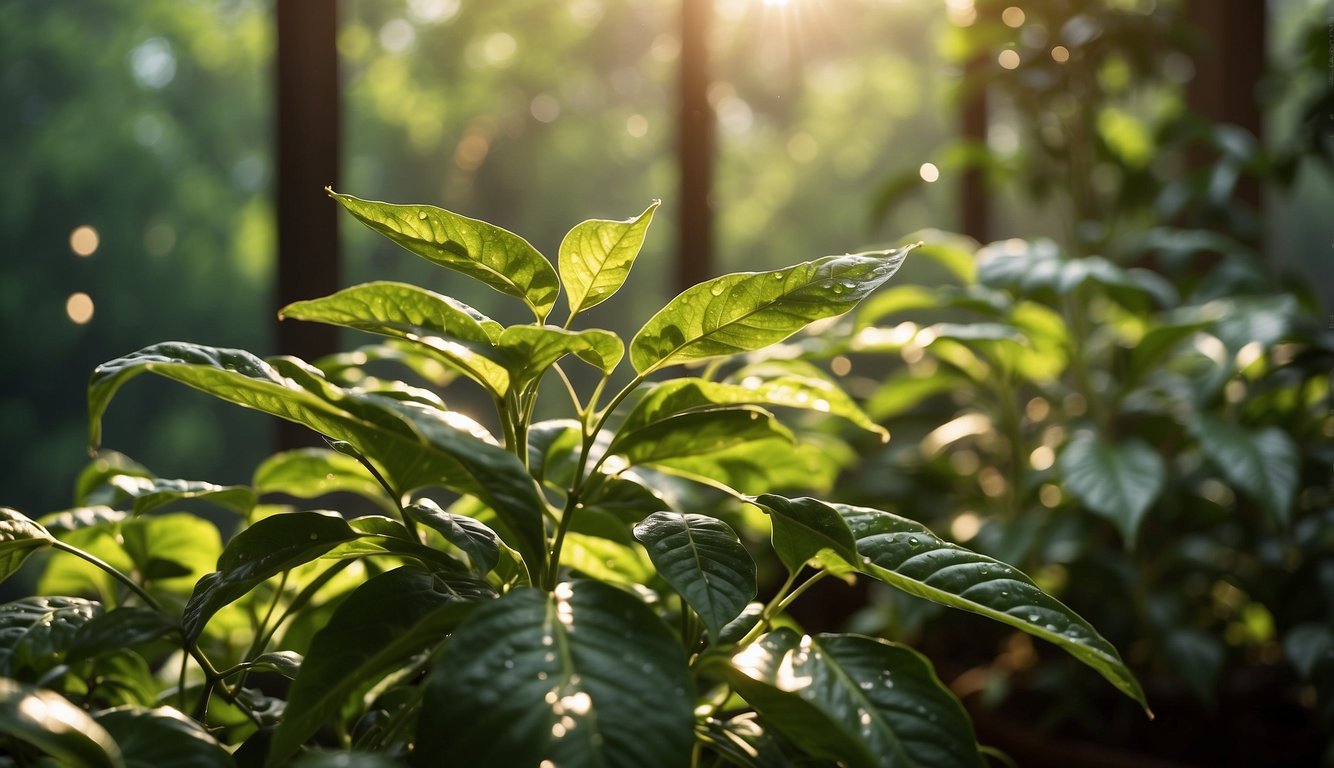
As an avid coffee lover, I have always been fascinated by the idea of growing my own coffee plant. However, before embarking on this journey, it is essential to understand the optimal growing conditions required for a coffee plant to thrive.
Light Requirements
Coffee plants require bright, indirect light to grow. Direct sunlight can scorch the leaves, so it is best to place the plant near a window that receives indirect light.
If the plant does not receive enough light, it may become leggy and weak.
Temperature and Humidity
Coffee plants prefer warm temperatures between 60-70°F (15-24°C). They also require high humidity levels, so it is best to place a tray of water near the plant or mist the leaves regularly.
During the winter months, it is essential to keep the plant away from drafts.
Soil and Drainage
Coffee plants require well-draining soil that is rich in organic matter. A soil mix that is specifically formulated for acid-loving plants is ideal.
Good drainage is crucial as coffee plants do not tolerate waterlogged soil.
It is important to keep the soil moist but not soaking wet, as overly dry soil can cause the leaves to wilt.
Coffee Plant Care and Maintenance
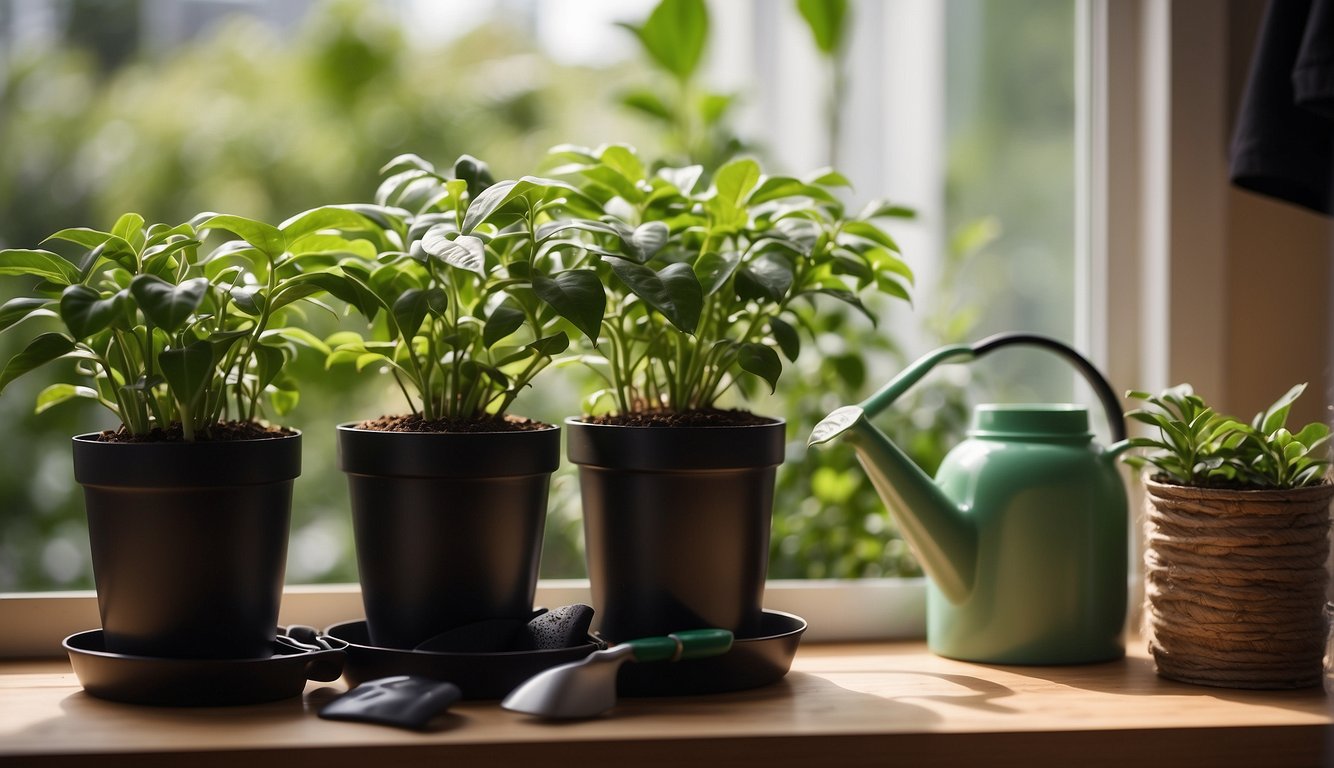
Growing a coffee plant as an indoor houseplant is a great way to enjoy the lush green foliage and the subtle aroma of coffee. Proper care and maintenance are essential for the plant to thrive and produce the best leaves and beans. Here are some tips for caring for your coffee plant:
Watering Practices
The coffee plant requires moderate watering. Overwatering or underwatering can lead to problems such as root rot or leaf drop.
I recommend watering your coffee plant when the top inch of soil is dry to the touch.
It is essential to avoid getting water on the leaves, as this can cause leaf spot or other fungal diseases.
To prevent this, I suggest watering the plant from the bottom by placing it in a saucer filled with water and letting it soak up the water for a few minutes.
Fertilization Techniques
Fertilizing your coffee plant is essential for its growth and health.
I recommend using a balanced liquid fertilizer once a month during the growing season (spring and summer).
Dilute the fertilizer to half strength to avoid overfertilization, which can lead to leaf burn.
During the dormant season (fall and winter), reduce the frequency of fertilization to once every two months.
Pruning and Shaping
Pruning your coffee plant is essential for maintaining its shape and size.
I suggest pruning the plant in the spring or summer when it is actively growing.
Use sharp, clean pruning shears to remove any dead, damaged, or diseased branches.
You can also prune the plant to control its size and shape.
I recommend removing no more than one-third of the plant’s foliage at a time to avoid stressing the plant.
Repotting and Transplanting
Repotting your coffee plant is essential for its growth and health.
I recommend repotting the plant every two to three years or when it outgrows its current container.
Choose a pot that is one size larger than its current container, and use well-draining soil with organic matter.
When transplanting, be careful not to damage the plant’s roots.
Gently loosen the root ball and remove any dead or damaged roots.
Place the plant in the new container and fill in around it with fresh soil, making sure to keep the plant at the same height it was in the previous container.
Propagation Methods
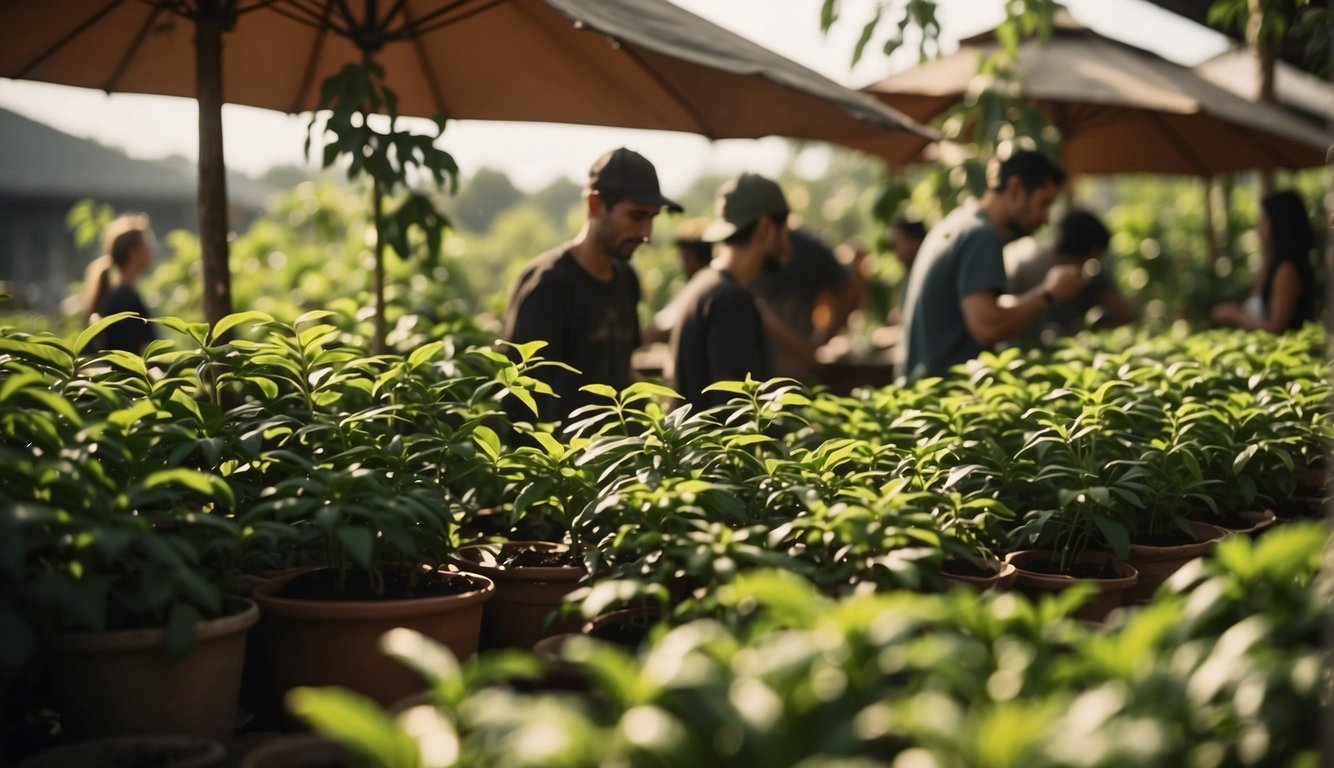
As a coffee house plant enthusiast, I have found that propagating coffee plants is a rewarding experience. There are two primary methods of propagation: seed germination and stem cuttings.
Seed Germination
Growing coffee plants from seeds can be an exciting process.
To begin, obtain fresh coffee seeds from a local coffee farm or nursery.
Soak the seeds in water for 24 hours to soften the outer shell and improve germination.
Fill a seed tray or small pots with well-draining potting mix and plant the seeds about 1 inch deep.
Keep the soil moist and place the tray or pots in a warm, bright location. Germination can take anywhere from 2-4 weeks.
Stem Cuttings
Stem cuttings are another method of propagating coffee plants.
To start, take a cutting from an established coffee plant that is 6-8 inches long and has at least three leaves.
Use pruning shears to cut the stem at an angle just below a node, which is a small bump on the stem where the leaves grow.
Remove the bottom leaf from the stem, leaving only two leaves at the top.
Dip the cut end of the stem in rooting hormone and plant it in a well-draining potting mix.
Keep the soil moist and place the pot in a warm, bright location. Roots should begin to form within 2-3 weeks.
Common Pests and Diseases
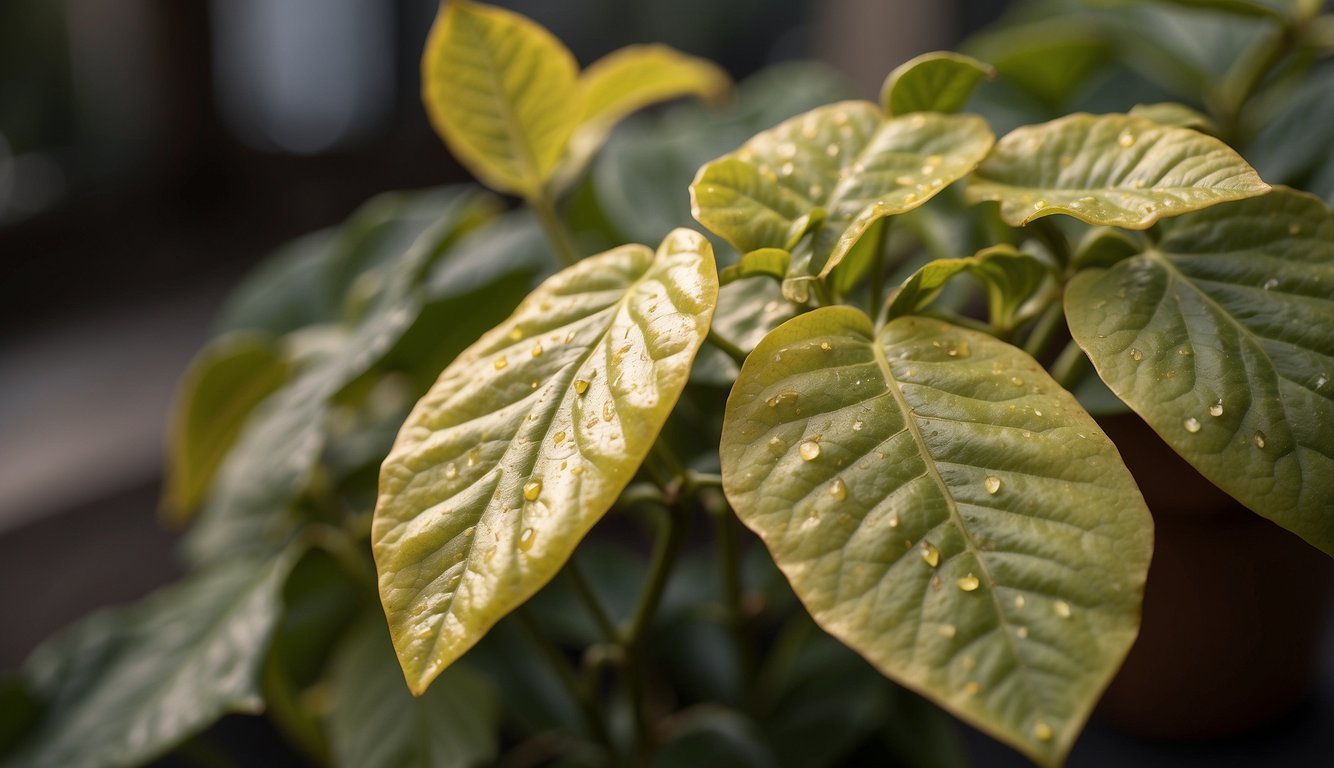
As with any plant, coffee house plants are susceptible to a variety of pests and diseases. Identifying and treating these issues early on is key to maintaining the health and vitality of your coffee plant. In this section, I will cover some of the most common pests and diseases that coffee house plants are prone to, as well as provide tips on how to identify and prevent them.
Identifying Pests
One of the most common pests that coffee house plants encounter are mealybugs.
These small, white insects are often found on the undersides of leaves and along the stems of the plant. They feed on the sap of the plant and can cause yellowing and wilting of the leaves.
To treat a mealybug infestation, it is important to isolate the plant and remove any affected leaves or stems. You can also use a solution of water and dish soap to kill the bugs.
Another common pest that affects coffee house plants are aphids.
These small, soft-bodied insects are usually found on the new growth of the plant and can cause stunted growth and yellowing of the leaves.
To treat an aphid infestation, you can use a solution of water and neem oil or insecticidal soap.
It is also important to remove any affected leaves or stems and isolate the plant to prevent the infestation from spreading.
Disease Prevention
In addition to pests, coffee house plants are also susceptible to a variety of diseases.
One of the most common diseases that affects coffee plants is coffee rust.
This fungal disease causes yellowing and premature dropping of the leaves, as well as decreased fruit production.
To prevent coffee rust, it is important to maintain proper humidity levels and ensure good air circulation around the plant.
You can also use a copper-based fungicide to treat an existing infection.
Another common problem that affects coffee house plants is overwatering.
This can lead to root rot, which can cause the plant to wilt and die.
To prevent overwatering, it is important to allow the soil to dry out between waterings and to ensure that the plant is not sitting in standing water.
Additionally, it is important to use a well-draining soil mix and to avoid using a pot that is too large for the plant.
Harvesting Coffee at Home
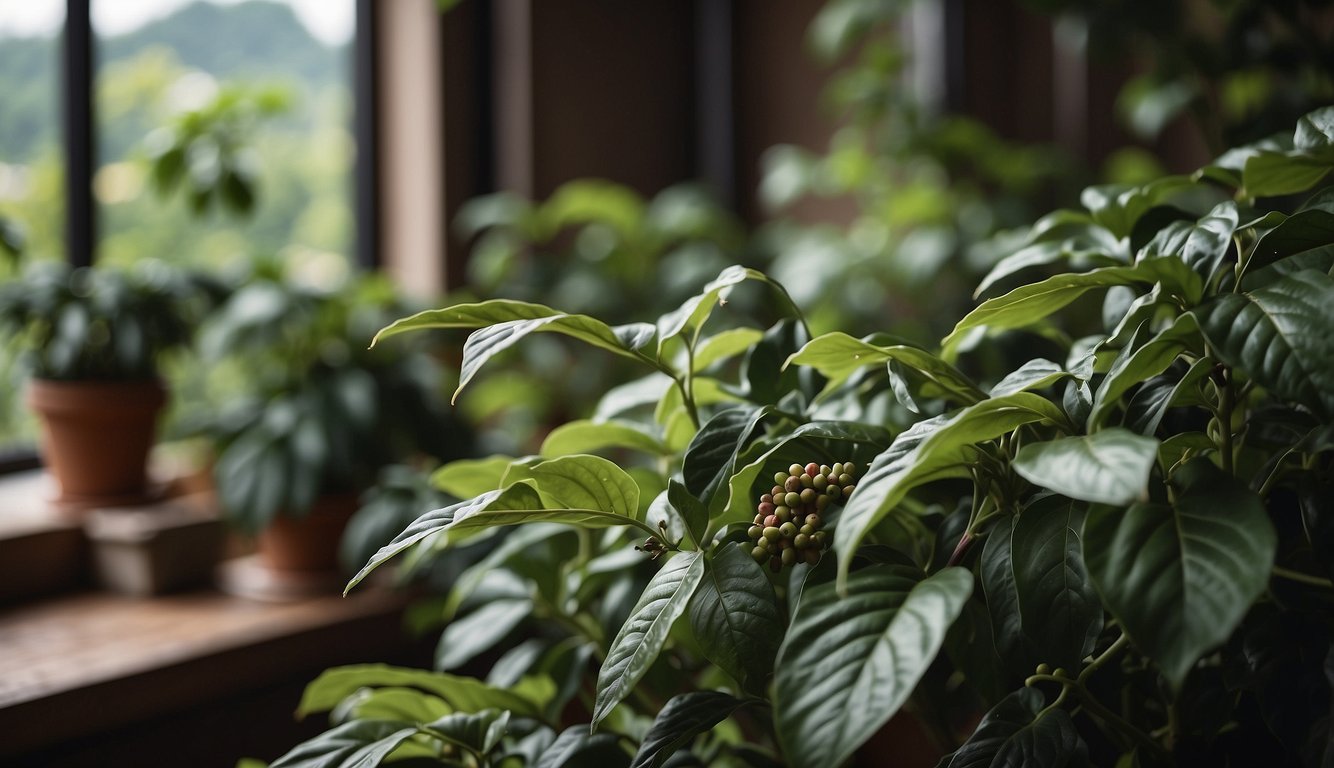
As a coffee plant owner, I look forward to the day when my plant produces its first coffee cherries. Harvesting coffee at home is a rewarding experience that requires patience and attention to detail. In this section, I will share my knowledge of harvesting coffee at home.
From Flower to Berry
Coffee plants bloom in the spring and summer, producing small, fragrant white flowers. These flowers are short-lived, lasting only a few days.
After the flowers fade, small green berries appear on the plant. As the berries mature, they turn red and become plump and juicy. It takes about 9 months for coffee cherries to ripen from the time the flowers bloom.
When the coffee cherries are ripe, they are ready to be harvested. I pick the cherries by hand, selecting only the ripest ones. It is important to harvest the cherries at the right time to ensure the best flavor.
If the cherries are picked too early, they will not have developed their full flavor. If they are picked too late, they may have started to rot.
Processing Coffee Beans
After the coffee cherries are harvested, they need to be processed to remove the coffee beans. There are two main methods of processing coffee beans: the dry method and the wet method.
The dry method involves laying the coffee cherries out in the sun to dry. Once the cherries are dry, they are crushed to remove the outer layer, revealing the coffee beans inside.
The wet method involves removing the outer layer of the coffee cherry using water. The coffee beans are then fermented to remove any remaining pulp. The beans are then washed and dried.
Once the coffee beans have been processed, they are ready to be roasted. Roasting coffee beans is an art form that requires skill and experience. The beans are roasted at high temperatures to bring out their unique flavors and aromas.
Safety and Precautions – Coffee House Plant
As with any houseplant, it is important to take safety precautions when cultivating and caring for a coffee plant. In this section, I will cover the toxicity of coffee plants to pets and humans and provide safe cultivation practices.
Toxicity to Pets and Humans
Coffee plants contain caffeine and other alkaloids that can be toxic to pets and humans if ingested in large quantities.
Symptoms of caffeine poisoning in pets can include restlessness, rapid breathing, heart palpitations, muscle tremors, and seizures. In humans, caffeine poisoning can cause similar symptoms, as well as nausea, vomiting, and diarrhea.
To prevent accidental ingestion, it is important to keep coffee plants out of reach of pets and children. If you suspect your pet or child has ingested any part of a coffee plant, seek medical attention immediately.
Safe Cultivation Practices
To ensure the safety of your household, it is important to follow safe cultivation practices when growing a coffee plant. Here are some tips:
- Wear gloves when handling the plant to prevent skin irritation or allergic reactions.
- Use a well-draining potting mix to prevent water from accumulating in the soil and causing root rot.
- Place the plant in a location with bright, indirect light and moderate humidity.
- Water the plant regularly, but do not overwater. Allow the soil to dry out slightly between waterings.
- Fertilize the plant with a balanced, water-soluble fertilizer every two weeks during the growing season.
Additional Considerations – Coffee House Plant

When caring for a coffee plant, there are a few additional considerations to keep in mind that can help ensure its health and beauty. In this section, I will go over some important factors to keep in mind when it comes to selecting the right container, decorative aspects of coffee plants, and the psychological benefits of having a coffee plant in your home.
Selecting the Right Container
When selecting a container for your coffee plant, it is important to choose one that is the right size and material.
The container should be large enough to accommodate the plant’s root system while also allowing for proper drainage. A container made of terra cotta or ceramic is a good choice as it is porous and allows for proper airflow to the roots. It is also important to choose a container that matches the style of your home decor.
Decorative Aspects of Coffee Plants
Coffee plants are not only great for their glossy green leaves and fragrant white flowers, but they can also add a decorative touch to any room.
Consider placing your coffee plant near a window where it can receive bright, indirect light. This will not only help the plant thrive but also add a touch of greenery to your space. You can also place your coffee plant on a decorative stand or table to give it a more prominent display.
Psychological Benefits
In addition to their decorative aspect, coffee plants can also have psychological benefits.
Studies have shown that indoor plants, such as coffee plants, can help improve mood and reduce stress levels. The act of caring for a plant can also be therapeutic and provide a sense of accomplishment. Having a coffee plant in your home can also serve as a reminder of your love for coffee and the joy it brings to your life.
Brewing Coffee House Plant with TheHerbProf
Let’s explore how our Coffee House Plant guide and the herbal wisdom at theherbprof.com can work together.
Our Coffee House Plant guide is your first step to a successful indoor coffee plant. But what about the rest of the journey? That’s where theherbprof.com comes in. It’s your herbal encyclopedia, including coffee plant care!
Picture this. You’ve followed our Coffee House Plant guide and your coffee plant is thriving. But you’re unsure about pest control or when to water. No problem! Theherbprof.com has all the answers. It offers a wealth of information on how to care for your coffee plant.
And there’s more! Theherbprof.com also shares the health benefits of coffee. So, while you’re enjoying the fruits of your labor, you’re also learning about their nutritional value.
So, let’s get growing with our Coffee House Plant guide and let theherbprof.com guide us on this coffee-growing journey.
References – Coffee House Plant
Little Herb Encyclopedia, by Jack Ritchason; N.D., Woodland Publishing Incorporated, 1995
The Ultimate Healing System, Course Manual, Copyright 1985, Don Lepore
Planetary Herbology, Michael Tierra, C.A., N.D., Lotus Press, 1988
Handbook of Medicinal Herbs, by James A. Duke, Pub. CRP Second Edition 2007
The Complete Medicinal Herbal, by Penelope Ody, Published by Dorling Kindersley
Check the Following Articles!
How to Transplant Aloe Vera? Step-by-Step Guide
Pruning Tomatillo Plants: A Guide for Optimal Growth
Storage Apples: How to Keep Them Fresh for Longer
How to Grow Carrots in a Container? Tips and Tricks
Frequently Asked Questions – Coffee House Plant
How do you take care of an indoor coffee plant?
Taking care of an indoor coffee plant involves providing it with the right amount of water, sunlight, and nutrients.
Water your coffee plant regularly, but do not overwater it. Allow the top inch of soil to dry out before watering it again. Coffee plants prefer bright, indirect sunlight, so place them near a window that receives filtered light. Use a fertilizer that is high in nitrogen to promote healthy growth.
What are the growth stages of a coffee plant?
Coffee plants go through several growth stages, including germination, seedling, vegetative, and reproductive.
During the germination stage, the seed sprouts and sends out a root. In the seedling stage, the plant develops its first true leaves and begins to grow taller. During the vegetative stage, the plant grows more leaves and branches. Finally, during the reproductive stage, the plant produces flowers and then fruit.
Where can I find a coffee plant for sale?
Coffee plants can be found for sale at many nurseries and garden centers. They can also be purchased online from various retailers. When purchasing a coffee plant, look for a healthy plant with a good root system and several leaves.
What type of fertilizer should be used for a coffee plant?
Coffee plants benefit from a fertilizer that is high in nitrogen, such as a 20-10-10 or 12-4-8 blend.
Fertilize your coffee plant once a month during the growing season, from spring to fall. Dilute the fertilizer to half strength before applying it to the plant.
Is the coffee plant considered toxic to pets or humans?
Coffee plants are not considered toxic to humans, but the beans can cause gastrointestinal upset if consumed in large amounts. However, coffee plants are toxic to pets, especially cats and dogs. Keep your coffee plant out of reach of pets to avoid accidental ingestion.
How much light is required for a healthy coffee plant?
Coffee plants prefer bright, indirect light.
Place your plant near a window that receives filtered light, or use a grow light to supplement natural light.
Avoid placing your coffee plant in direct sunlight, as this can scorch the leaves.
